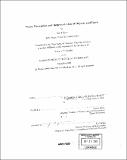| dc.contributor.advisor | Pawan Sinha. | en_US |
| dc.contributor.author | Sadr, Javid, 1973- | en_US |
| dc.contributor.other | Massachusetts Institute of Technology. Dept. of Brain and Cognitive Sciences. | en_US |
| dc.date.accessioned | 2006-03-24T18:09:29Z | |
| dc.date.available | 2006-03-24T18:09:29Z | |
| dc.date.copyright | 2003 | en_US |
| dc.date.issued | 2003 | en_US |
| dc.identifier.uri | http://hdl.handle.net/1721.1/29988 | |
| dc.description | Thesis (Ph. D.)--Massachusetts Institute of Technology, Dept. of Brain and Cognitive Sciences, 2003. | en_US |
| dc.description | Includes bibliographical references (leaves 87-95). | en_US |
| dc.description.abstract | Interpreting the results of visual object perception experiments is too often ill-posed due to the disparate and sparse choice of stimuli. To address this problem, we have developed a flexible new technique called Random Image Structure Evolution (RISE). In the simplest case, RISE involves the presentation of image sequences depicting the evolution of a coherent image from a seemingly random field, along with the reverse sequences depicting the transformation back into randomness. As it samples a subset of the space of possible stimulus images, RISE image processing strictly preserves low-level attributes such as frequency spectra and luminance, and RISE experiments are designed to provide objectively verifiable measures of the onset and offset of subjects' conscious percepts. In turn, these onset and offset measures can serve as quantitative markers for characterizing a number of intriguing perceptual phenomena. Here I describe the basic RISE paradigm and discuss experimental applications of this technique which, it is hoped, may contribute greatly to the study of key aspects of high-level vision. Building on results from psychophysical studies of perceptual onset, priming, and hysteresis, as well as findings from a magnetoencephalographic study using RISE, this thesis explores the use of RISE in characterizing the perceptual markers and neural substrates of object and face perception. In addition, this thesis examines the issue of object perception and, in particular, robust face perception, within the context of the cortical representations that may underly them, presenting and evaluating a simple, well-motivated image coding scheme based on ordinal relations. | en_US |
| dc.description.statementofresponsibility | by Javid Sadr. | en_US |
| dc.format.extent | 95, [1] leaves | en_US |
| dc.format.extent | 5124594 bytes | |
| dc.format.extent | 5124401 bytes | |
| dc.format.mimetype | application/pdf | |
| dc.format.mimetype | application/pdf | |
| dc.language.iso | eng | en_US |
| dc.publisher | Massachusetts Institute of Technology | en_US |
| dc.rights | M.I.T. theses are protected by copyright. They may be viewed from this source for any purpose, but reproduction or distribution in any format is prohibited without written permission. See provided URL for inquiries about permission. | en_US |
| dc.rights.uri | http://dspace.mit.edu/handle/1721.1/7582 | |
| dc.subject | Brain and Cognitive Sciences. | en_US |
| dc.title | Visual perception and representation of objects and faces | en_US |
| dc.type | Thesis | en_US |
| dc.description.degree | Ph.D. | en_US |
| dc.contributor.department | Massachusetts Institute of Technology. Department of Brain and Cognitive Sciences | |
| dc.identifier.oclc | 54792260 | en_US |
